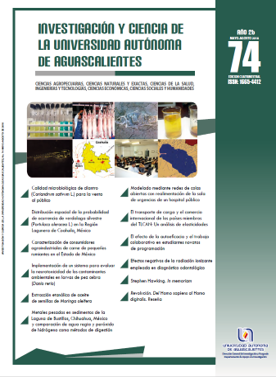Modelado mediante redes de colas abiertas con realimentación de la sala de urgencias de un hospital público
DOI:
https://doi.org/10.33064/iycuaa2018741737Palabras clave:
modelo de colas, sala de urgencias, matriz de ruta de probabilidades, indicadores de eficiencia.Resumen
Este trabajo propone un modelo de red de colas abiertas con realimentación, de la sala de urgencias, para entender su comportamiento y tomar decisiones estratégicas. Se establece una matriz de ruta de
probabilidades en la red de colas para determinar de manera general las variantes de comportamiento de este modelo, generando así un rango de escenarios con diferentes patrones de comportamiento; con los resultados numéricos, se analizan los indicadores de eficiencia de la Teoría de Colas de las tres locaciones: consultorios, laboratorios y observación-yesos-suturas, las cuales se modelan con M/M/s, M/G/1 y M/M/1, respectivamente. Los resultados del análisis numérico muestran la sensibilidad del comportamiento de la sala de urgencias con base en los valores de la matriz de ruta de probabilidades y en cuáles valores funciona óptimamente.
Descargas
Citas
• Au-Yeung, S. W. M., Harrison, P. G., & Knottenbelt, W. J. (2006). A queueing network model of patient flow in an accident and emergency department. Proceedings of the 20th Annual European and Simulation Modelling Conference, 60-67.
• Cochran, J. K., & Roche, K. T. (2009). A multi-class queuing network analysis methodology for improving hospital emergency department performance. Computers and Operations Research, 36(5), 1497-1512. doi: 10.1016/j.cor.2008.02.004
• Côté, M. J. (2000). Understanding patient flow. Decision Line, 31(2), 8-10.
• Derlet, R. W., Richards, J. R., & Kravitz, R. L. (2008). Frequent overcrowding in US emergency departments. Academic Emergency Medicine, 8(2), 151-155. doi: 10.1111/j.1553-2712.2001.tb01280.x
• Filipowicz, B., & Kwiecień, J. (2008). Queueing systems and networks. Models and applications. Bulletin of the Polish Academy of Sciences, Technical Sciences, 56(4), 379-390.
• Gómez Dantés, O., Sesma, S., Becerril, V. M., Knaul, F. M., Arreola, H., & Frenk, J. (2011). Sistema de salud de México. Salud Pública de Mexico, 53(Supl. 2), S220-S232. Recuperado de http://www.scielo.org.mx/pdf/spm/v53s2/17.pdf
• Gross, D., & Harris, C. M. (1998). Fundamentals of queueing theory (3nd. ed.). John Wiley & Sons. doi: 10.1002/9781118625651
• Hillier, F. S., & Lieberman, G. J. (2001). Introduction to Operation Research (7th ed.). New York, NY: McGraw Hill.
• Hospitalesmexico.com © Datos públicos. (s. f.). Directorio hospitales, clínicas y consultorios en México [Portal electrónico]. Recuperado de https://hospitalesmexico.com/
• Izady, N., & Worthington, D. (2012). Setting staffing requirements for time dependent queueing networks: The case of accident and emergency departments. European Journal of Operational Research, 219(3), 531-540. doi:10.1016/j.ejor.2011.10.040
• Jiang, L., & Giachetti, R. E. (2008). A queueing network model to analyze the impact of parallelization of care on patient cycle time. Health Care Management Science, 11(3), 248-261. doi: 10.1007/s10729-007-9040-9
• Jlassi, J., Mhamedi, A. E., & Chabchoub, H. (2009). Networks of queues with multiple customer types: Application in emergency departments. International Journal of Behavioural and Healthcare Research, 1(4), 400. doi: 10.1504/IJBHR.2009.032157
• Krieger, U. R. (2008). Queueing networks and Markov chains, 2nd edition by G. Bolch, S. Greiner, H. de Meer, and K. S. Trivedi. John Wiley & Sons, Hoboken, NJ, 2006, 878 pages, ISBN 0-471-56525-3. Book review. IIE Transactions, 40(5), 567-568. doi: 10.1080/07408170701623187
• Mayhew, L., & Smith, D. (2008). Using queuing theory to analyse the government’s 4-H completion time target in accident and emergency departments. Health Care Management Science, 11(1), 11-21. doi: 10.1007/s10729-007-9033-8
• Olorunsola, S. A., Adeleke, R. A., & Ogunlade, T. O. (2014). Queueing analysis of patient flow in hospital. IOSR Journal of Mathematics, 10(4) Ver. VI, 47-53.
• Vázquez I., J. A., González S., R. A., & Juárez L., H. A. (2014). Modelado computacional de un servicio de urgencias considerando las variables relacionadas con el factor humano y con los tiempos de atención en consulta de acuerdo con el diagnóstico (Tesis doctoral). Centro Universitario de los Lagos-UdeG, México.
• Véricourt, F. de, & Jennings, O. B. (2011). Nurse staffing in medical units: A queueing perspective. Operations Research, 59(6), 1320-1331. doi: 10.1287/opre.1110.0968
• Zhu, H., Gong, J., & Tang, J. (2013). A queuing network analysis model in emergency departments. IEEE Xplore, 1829-1834.
Descargas
Publicado
Cómo citar
Licencia
Las obras publicadas en versión electrónica de la revista están bajo la licencia Creative Commons Atribución-NoComercial-CompartirIgual 4.0 Internacional (CC BY-NC-SA 4.0)









